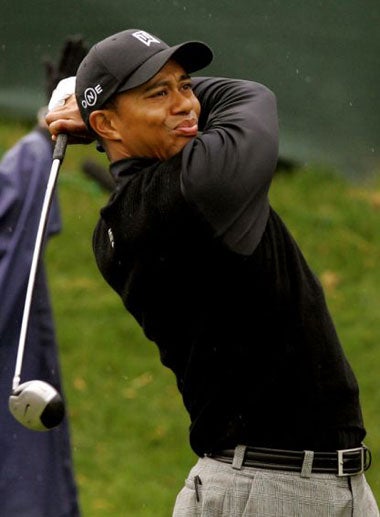Big hitters embark on a collision course
Changes to counter the advances of technology are criticised by legends of the green jacket

It used to be a Masters tradition for players and caddies to arrive for their first practice round at Augusta National and wonder whether the first tee had been moved - or the clubhouse. The evolution of the course was constant, if often undeclared. Under the chairmanship of Hootie Johnson, the pace of change has increased dramatically, and everyone knows about it.
So it was hardly surprising when last summer, while the course was closed for its annual renovations, it was announced that six more holes were being changed. The expanded course now measures 7,445 yards, or 155 yards longer than a year ago.
If the news was not surprising, nor was the reaction. Just how far are Augusta National prepared to go in order to combat the monster mashers of the modern game? The club have made a very public, and expensive, statement in the debate about technology in the game.
But not everyone agrees. Rarely do players speak out about the Masters but Jack Nicklaus and Arnold Palmer, both club members as well as honorary members - as former champions - have done so.
"I think they've ruined it from a tournament standpoint," Nicklaus told Golf Digest magazine. "Augusta has meant a ton to me in my lifetime. It's a big, big part of my life, and I love it. That's why I hate to see them change it." Palmer told the same magazine: "I love the place, just love everything that happens there. But now, I'm not so sure. It's changed dramatically from the course I knew the last 50 years."
Neither Nicklaus nor Palmer will be playing this year, and the changes may well push some of the other older champions into retirement from the event. It has been suggested that Nicklaus and Palmer are upset at not being consulted about the changes, which have been overseen by another course architect, but not a champion golfer, in Tom Fazio.
In keeping with their reserved public persona, the club make little comment about the philosophy behind the changes other than Johnson's curt "We will keep the course current with the times". And times change.
For most of the second half of the past century, while Nicklaus and Palmer were winning their 10 green jackets, the course measured 6,925 yards. Tiger Woods's victory in 1997 appeared to spur the club into action, but he was not the only one hitting a wedge to the 18th - virtually everyone was. Greg Norman missed that green in 1986 with a five-iron to hand Nicklaus his sixth title.
Augusta became determined not to end up a drive-and-wedge course. Other venues prevented this with thick rough, as at Sawgrass, home of the Players. But Augusta has never had significant rough, none at all until the "second cut" was introduced in 1999.
Unless it is thick and juicy, rough seems to be little deterrent to today's bombers. This season Woods ranks 140th in driving accuracy but still manages to be first in greens in regulation. In the final round at Doral, where he won the Ford Championship, he hit only four fairways but still made it on to 16 greens. Johnny Miller has suggested square-grooved wedges may be even more important than the ball.
All the "second cut" appears to have done, especially in recent wet conditions, is stop balls running into the trees. This may be one reason the club keep adding new pines, on the right of the 11th fairway, for example, which also gets up the old-timers' noses.
Augusta was once a very subtle course - drive it anywhere on these wide open fairways, but you will have a better chance if you hit it exactly here. "Bobby Jones believed golf was primarily a second-shot game," said Nicklaus. "He believed you should have enough room to drive the ball on to the fairway, but if you put it on the correct side of the fairway, you had an advantage to put the ball toward the hole. He wanted to give you a chance to do that shot."
The sheer distancesare forcing the course to be more obvious. So at the 11th, changed for a fourth time since 1999 despite being the hardest hole in two of the past three tournaments, the new treesforce the approach to flirt more with the pond at the front-left of the green. At the first, the tee is practically on the putting green. The carry over the (enlarged and deepened) bunker on the right is 331 yards.
Clearly the extra length helps the bigger hitters, but since the course has not played truly hard and fast in recent years due to rain, the jury is still out. Big hitters such as Palmer and Nicklaus always had an advantage at Augusta, butmid- to long-iron players such as Faldo, Langer and Olazabal also had a chance. Apart from Luke Donald, third last year, where are their successors?
Woods has seen the changes. "It's long, very long," he said, adding the warning: "If it's soaked again, I think that eliminates a lot of guys who have the skill to play but just don't hit the ball far enough." Pray for sunshine.
Subscribe to Independent Premium to bookmark this article
Want to bookmark your favourite articles and stories to read or reference later? Start your Independent Premium subscription today.

Join our commenting forum
Join thought-provoking conversations, follow other Independent readers and see their replies